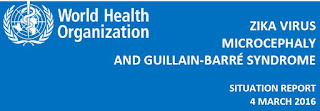# 11,097
The World Health Organization has published its 5th weekly Situation report on Zika, Microcephaly and GBS, and in this 15-page PDF file you'll find the latest charts, maps and data.
SUMMARY
- Between 1 January 2007 and 3 March 2016, a total of 52 countries and territories have reported autochthonous (local) transmission or indication of transmission of Zika virus (41 since 1 January 2015). Five of these countries and territories reported a Zika virus outbreak that is now over. In addition, three countries and territories have reported locally acquired infection, probably through sexual transmission.
- Among the 52 countries and territories, Lao People’s Democratic Republic is the latest to report autochthonous transmission of Zika virus. France, Italy and the United States of America have reported locally acquired Zika virus infection in the absence of any known mosquito vectors.
- The geographical distribution of Zika virus has steadily widened since the virus was first detected in the Americas in 2015. Autochthonous Zika virus transmission has been reported in 31 countries and territories of this region. Zika virus is likely to be transmitted and detected in other countries within the geographical range of competent mosquito vectors, especially Aedes aegypti.
- So far an increase in microcephaly cases and other neonatal malformations has only been reported in Brazil and French Polynesia, although two cases linked to a stay in Brazil were detected in the United States of America and Slovenia.
- During 2015 and 2016, eight countries and territories have reported an increased incidence of Guillain-Barré syndrome (GBS) and/or laboratory confirmation of a Zika virus infection among GBS cases.
- A recently published case control study in French Polynesia provides further evidence of a causal relationship between Zika virus infection and GBS.
- The global prevention and control strategy launched by WHO as a Strategic Response Framework1 encompasses surveillance, response activities and research, and this situation report is organized under those headings. Following consultation with partners and taking changes in caseload into account, the framework will be updated at the end of March 2016 to reflect epidemiological evidence coming to light and the evolving division of roles and responsibilities for tackling this emergency.
Although we learn more and more about the Zika virus with each passing week there are still a great many unknowns, and some of the things we think we know today may not hold true a month or two from now.
A small example: Until very recently it was assumed that only the Aedes mosquito was a competent vector for the Zika virus, and that would help limit its geographic spread.
But as we saw yesterday (see Fiocruz: Zika Virus Experimentally Introduced Into Culex Mosquitoes) reseachers are only now starting to test other mosquito species, and while the answers aren't in yet, the `conventional wisdom' of a month ago may eventually require revision.
This research has likely has prompted the subtle changes in the language used in these WHO reports over the past month to describe mosquito vectors believed capable of spreading the Zika virus.
- On Feb 5th, the report read: Further spread to countries within the geographical range of competent disease vectors — Aedes mosquitoes — is considered likely.
- Today that wording is changed to : Zika virus is likely to be transmitted and detected in other countries within the geographical range of competent mosquito vectors, especially Aedes aegypti.
As we've been warned before with influenza, with Zika, we should also be prepared for surprises along the way.
